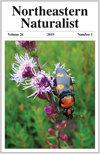A Longitudinal Assessment of Benthic Macroinvertebrate Diversity and Water Quality along the Bronx River
IF 0.5
4区 环境科学与生态学
Q4 BIODIVERSITY CONSERVATION
引用次数: 1
Abstract
Abstract - The Bronx River is an urban waterway with a long history of anthropogenic disturbance. We conducted a longitudinal assessment of the Bronx River's water quality by measuring benthic macroinvertebrate diversity at 6 sites along the river. We integrated long-term water-quality data collected by the New York State Department of Environmental Conservation. We found that the overall water quality of the river has remained moderately impacted over different timepoints throughout the past 22 years. The study site upstream of combined sewage overflows and municipal separate stormwater systems exhibited healthier biological profiles, whereas the most-downstream sites exhibited slight declines in water quality. The most recent survey of the Bronx River (2020) revealed that high invasive species dominance was associated with benthic macroinvertebrate communities that were less healthy. Notably, one invasive species not documented in historical surveys, Corbicula fluminea (Asian Clam), was sampled in 5 of 6 study sites during the 2020 surveys. Moreover, no species were sampled from the order Ephemeroptera (mayflies) in 2020 despite being present in previous surveys. These results can be used to guide the management of urban rivers.布朗克斯河沿岸底栖大型无脊椎动物多样性与水质的纵向评价
摘要:布朗克斯河是一条历史悠久的城市水道。通过测量布朗克斯河沿岸6个地点的底栖大型无脊椎动物多样性,对布朗克斯河的水质进行了纵向评估。我们整合了纽约州环境保护部收集的长期水质数据。我们发现,在过去22年的不同时间点,河流的整体水质仍然受到适度的影响。污水溢流和城市独立雨水系统的上游研究点显示出更健康的生物剖面,而大多数下游研究点的水质略有下降。对布朗克斯河(2020年)的最新调查显示,高入侵物种优势与不太健康的底栖大型无脊椎动物群落有关。值得注意的是,在2020年的调查中,在6个研究地点中的5个取样了一种在历史调查中没有记录的入侵物种——亚洲蛤(Corbicula fluinea)。此外,尽管之前的调查中有蜉蝣目(蜉蝣)的物种,但2020年没有从蜉蝣目(蜉蝣)中取样。这些结果可用于指导城市河流的管理。
本文章由计算机程序翻译,如有差异,请以英文原文为准。
求助全文
约1分钟内获得全文
求助全文
来源期刊

Northeastern Naturalist
环境科学-生态学
CiteScore
1.10
自引率
0.00%
发文量
42
审稿时长
18-36 weeks
期刊介绍:
The Northeastern Naturalist covers all aspects of the natural history sciences of terrestrial, freshwater, and marine organisms and the environments of the northeastern portion of North America, roughly bounded from Virginia to Missouri, north to Minnesota and Nunavut, east to Newfoundland, and south back to Virginia. Manuscripts based on field studies outside of this region that provide information on species within this region may be considered at the Editor’s discretion.
The journal welcomes manuscripts based on observations and research focused on the biology of terrestrial, freshwater, and marine organisms and communities as it relates to their life histories and their function within, use of, and adaptation to the environment and the habitats in which they are found, as well as on the ecology and conservation of species and habitats. Such studies may encompass measurements, surveys, and/or experiments in the field, under lab conditions, or utilizing museum and herbarium specimens. Subject areas include, but are not limited to, anatomy, behavior, biogeography, biology, conservation, evolution, ecology, genetics, parasitology, physiology, population biology, and taxonomy. Strict lab, modeling, and simulation studies on natural history aspects of the region, without any field component, will be considered for publication as long as the research has direct and clear significance to field naturalists and the manuscript discusses these implications.
 求助内容:
求助内容: 应助结果提醒方式:
应助结果提醒方式:


